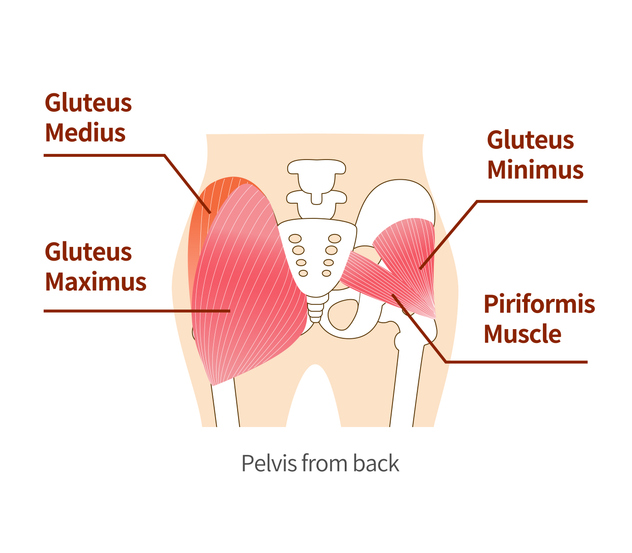Ever felt like your butt “fell asleep” after sitting for too long? If so, you’re not alone! This strange sensation could be a sign of Dead Butt Syndrome (DBS) – a condition that occurs when your gluteal muscles (the muscles in your buttocks) essentially “forget” their job after being inactive for long periods. While it sounds amusing, DBS can cause a range of issues, especially if it’s left untreated.
This may be a condition that affects older adults who spend too much time sitting in front of the tv or reading and not enough time moving and exercising. Is that you? Good news – it’s something you can fix.
What Exactly is Dead Butt Syndrome?
Dead Butt Syndrome, also known as gluteus medius tendinopathy or gluteal amnesia, occurs when your gluteal muscles become weak or inactive due to prolonged sitting. The main job of these muscles is to stabilize your pelvis and support proper body alignment. But when they’re not engaged regularly, they “forget” their purpose, leading to muscle imbalances, poor posture, and discomfort.
Common Symptoms
DBS usually starts with numbness or soreness in your buttocks after sitting for too long. This is your body’s way of saying, “Hey, it’s time to move!” If you get up and walk around, the sensation might disappear. But if you continue to sit for long periods without moving, the symptoms can become more severe.
Some people experience:
- Pain or stiffness in the hips, lower back, or knees
- Shooting pain down one leg, which may feel similar to sciatica
- Weakness in the glutes and hip flexors
- Hip bursitis (inflammation around the hip joint)
- Balance issues, which can lead to pain in the knees, ankles, or feet
When your glutes aren’t functioning properly, other muscles have to work harder to compensate. This imbalance can affect everything from your gait to your posture, increasing the risk of injury in other parts of your body.
Why Does This Happen?
The primary cause of DBS is a sedentary lifestyle – sitting or lying down for too long without enough movement. Your gluteal muscles lengthen when you sit, and your hip flexors tighten. Over time, this imbalance can lead to inflammation in the gluteal muscles and tendons, especially in the gluteus medius, a large fan-shaped muscle found in the posterior hip and running from the ilium to the proximal femur.
Interestingly, even athletes who spend long hours sitting at a desk are at risk. Runners, dancers, and other active individuals may develop DBS if they don’t balance their high-intensity workouts with regular movement breaks throughout the day.
How to Treat Dead Butt Syndrome
The good news is that DBS is treatable, and the earlier you catch it, the easier it is to reverse. Here’s what you can do to bring your glutes back to life:
- Take a Break from Sitting: Stand up, stretch, and move around every hour or so. Even a quick walk around the room can help reactivate your glute muscles.
- Follow the RICE Protocol: If you’re dealing with pain, especially after exercise, follow the RICE protocol: rest, ice, compression, and elevation. This will help reduce inflammation and promote healing.
- Incorporate Glute Exercises: Strengthening and stretching exercises can make a world of difference. Exercises like squats, leg lifts, and glute bridges can help wake up those muscles and prevent further issues.
- Consult a Specialist: If your symptoms persist, consider seeing a doctor, sports medicine specialist, or physical therapist. They can guide you through a personalized treatment plan, and if needed, suggest advanced therapies like platelet-rich plasma (PRP) injections.
Preventing Dead Butt Syndrome
The easiest way to prevent DBS is to move regularly. Set a timer on your phone or computer to remind you to stand, stretch, and walk every 30 to 60 minutes. Taking the stairs instead of the elevator or going for a quick stroll can also activate your gluteal muscles and help prevent DBS from creeping back into your life.
Adding simple exercises, such as hamstring stretches, glute squeezes, and squats, to your weekly routine can keep your muscles strong and flexible. If you’re a runner, working with a specialist to analyze your running form can ensure you’re not putting too much strain on your glutes.
Dead Butt Syndrome might sound funny, but the discomfort it causes is no joke. The key to avoiding DBS is to stay active, break up long periods of sitting, and strengthen your glutes and hip flexors. Now that another winter is within sight, it’s time to get routines nailed down including proper exercise.






Add Your Voice
0 Comments
Join the Discussion